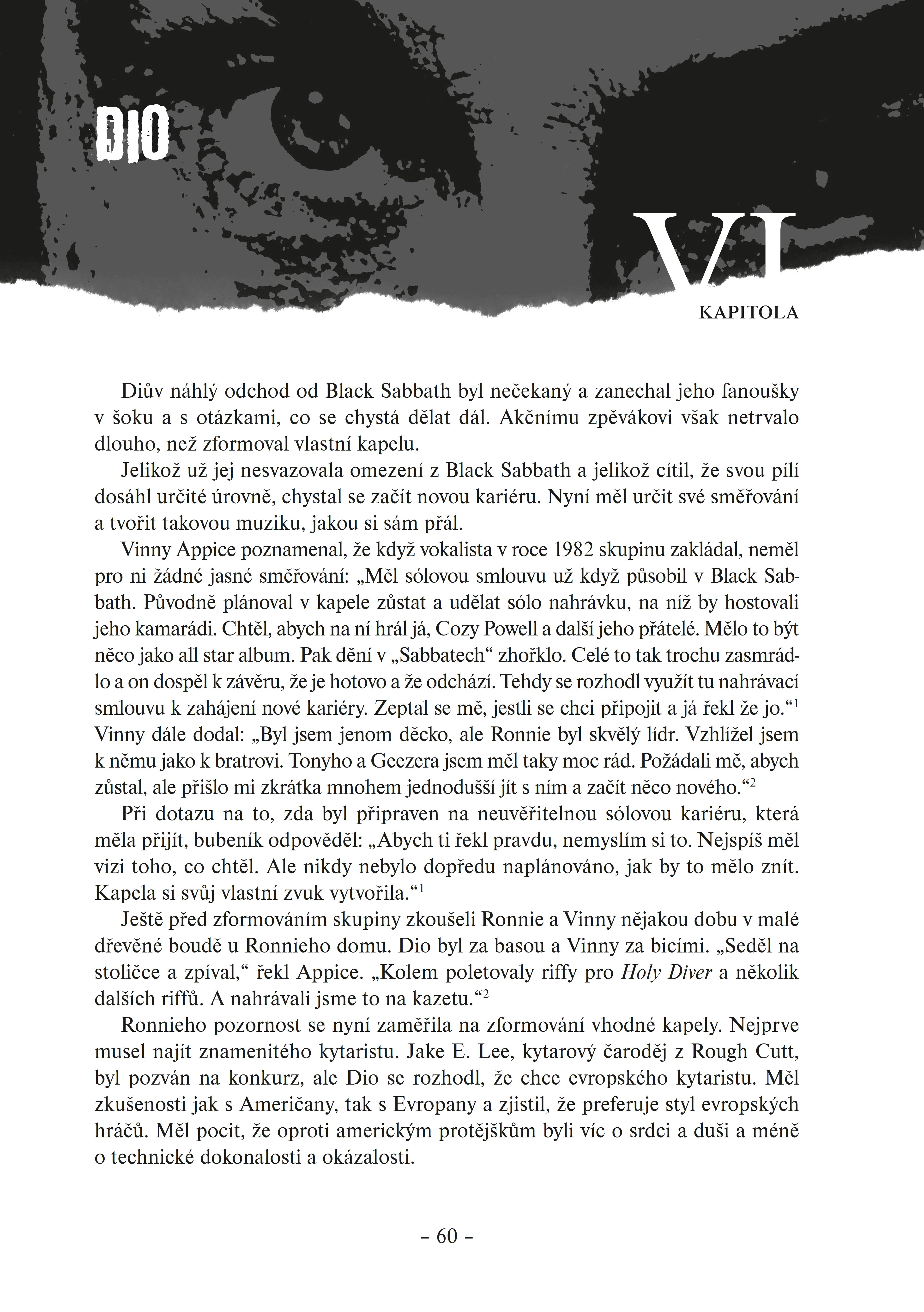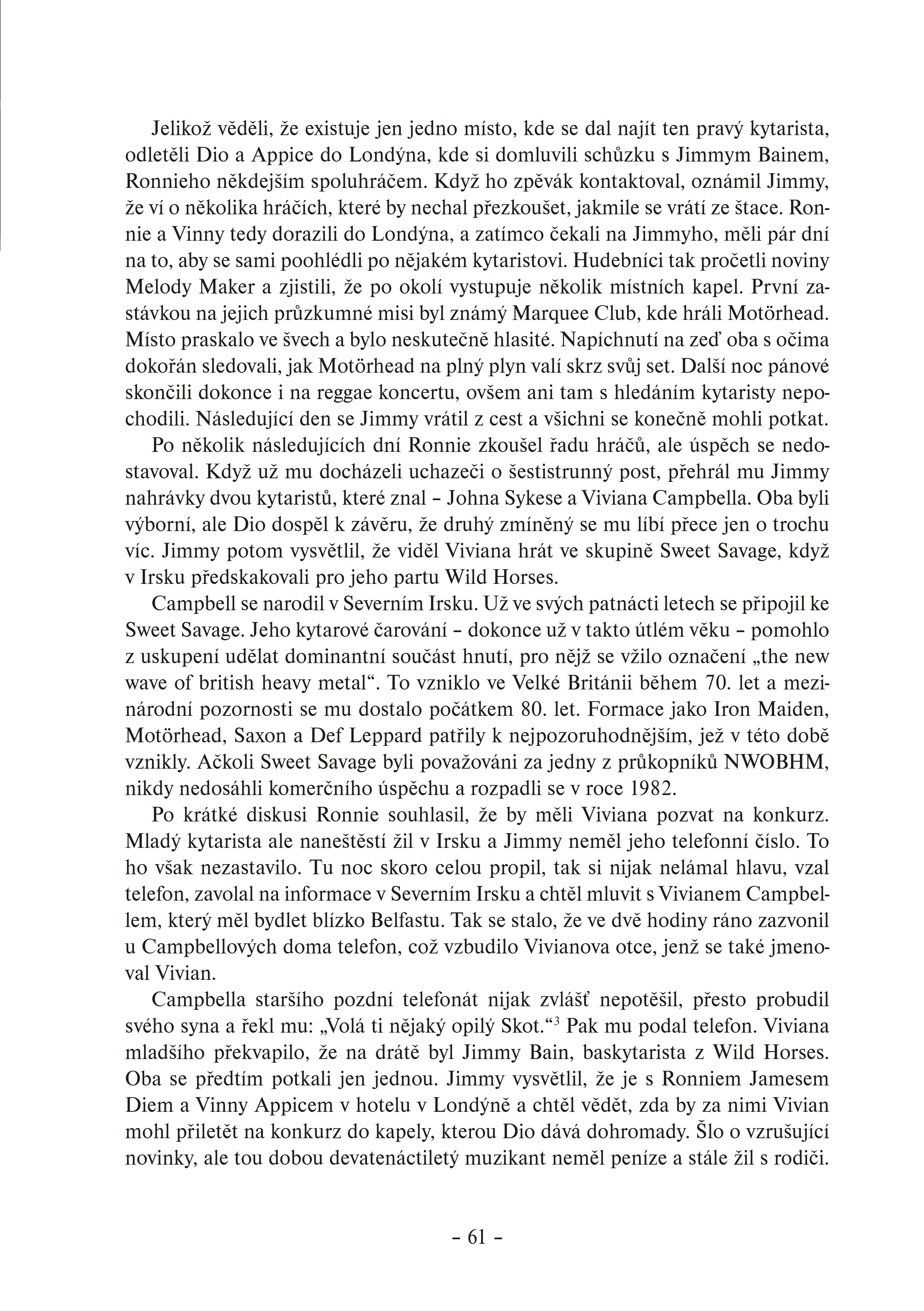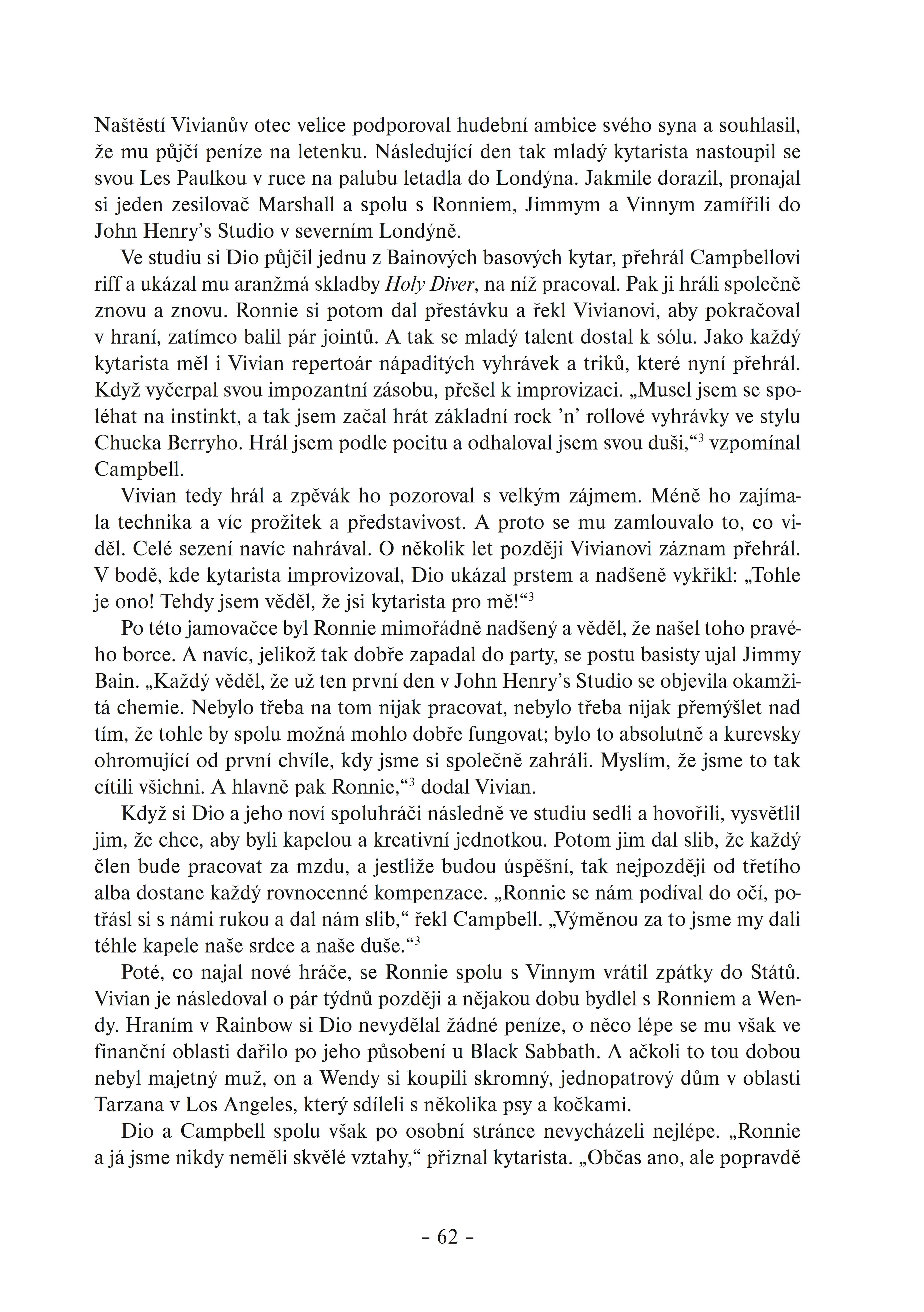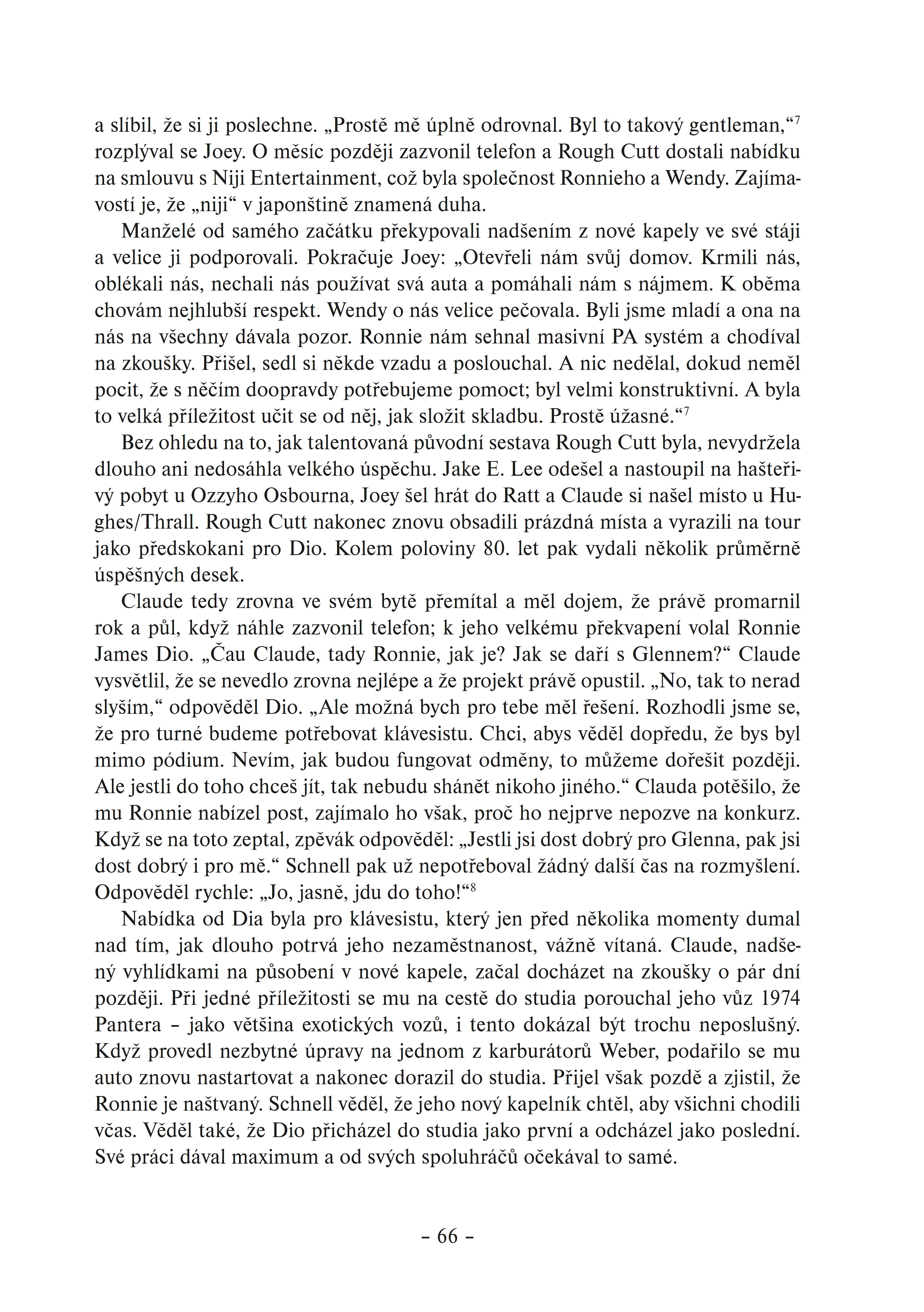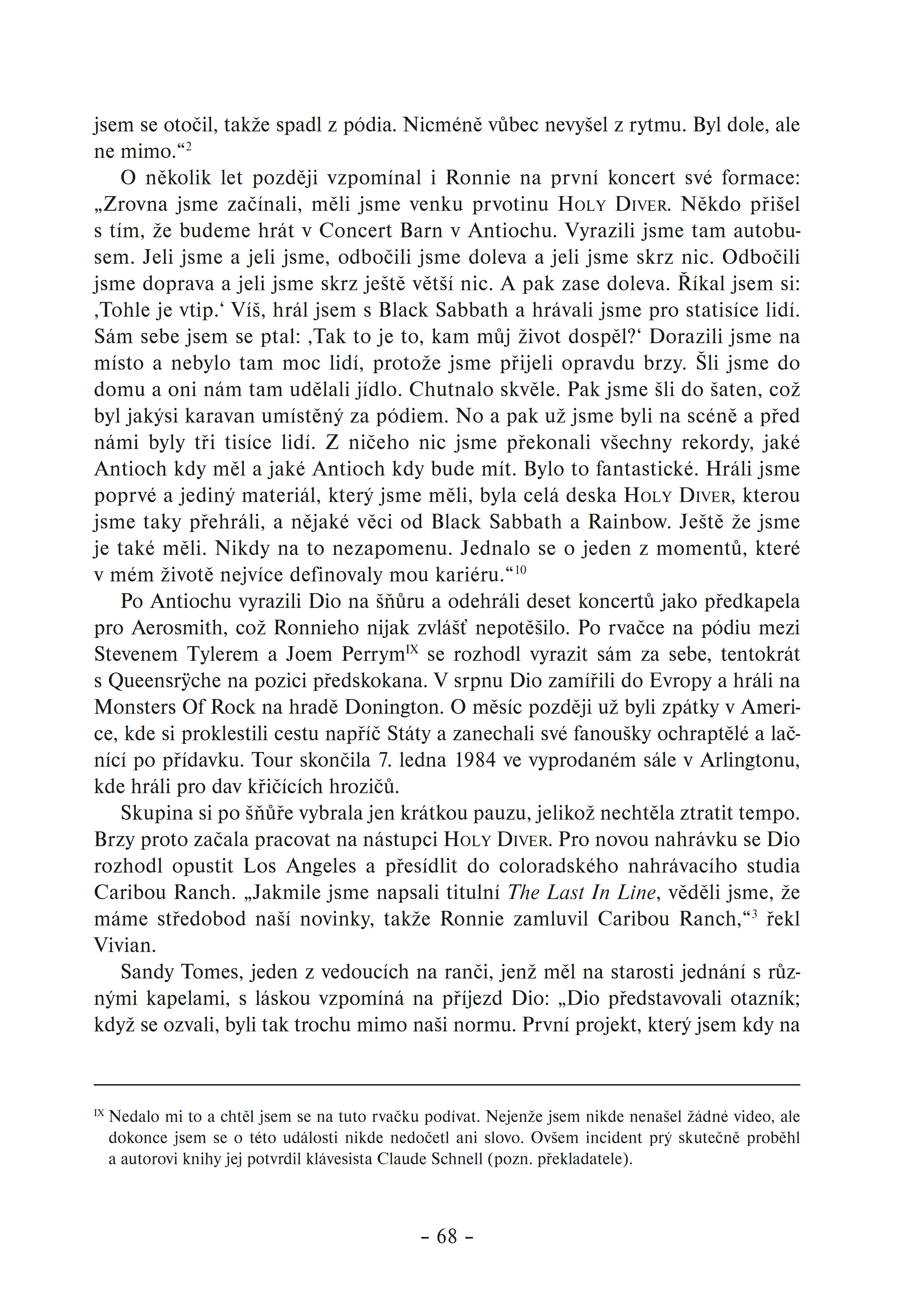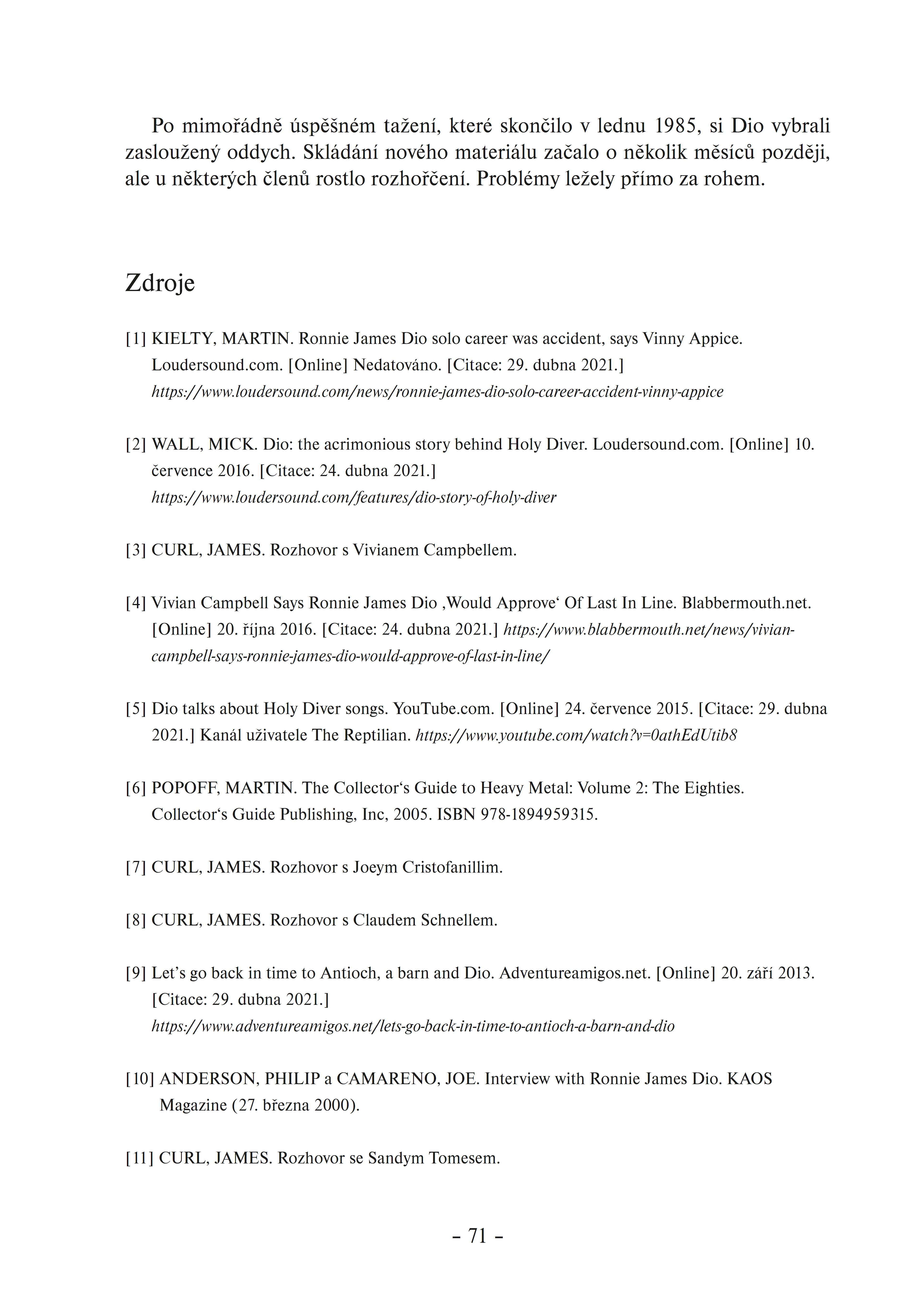Dear friends, welcome to the fourth installment of our coverage regarding the upcoming unofficial biography of the heavy metal legend Ronnie James Dio by the American writer James Curl. In today's transmission, we are following up our previous subject of the book contents, giving it even more concrete contours.
For we have here an excerpt from the Czech translation of "Ronnie James Dio: A Biograhy of a Heavy Metal Icon", specifically chapter six in its entirety, which covers the beginning of Dio's solo career after his departure from Black Sabbath.
Furthermore, the whole excerpt is presented as it will appear in our edition when printed, whereby you can check out the layout and typesetting, which was undertaken by Tomáš F. Hanzl, a.k.a. Chymus, (Isacaarum, Pačess, Inner Fear, Petroleum). Click on the individual images to zoom.
The English original text is as follows:
Chapter Six - Dio
Ronnie’s abrupt split from Black Sabbath was unexpected and left his fans stunned and wondering what he was going to do. It wouldn’t take long however for the resourceful vocalist to form his own band.
Unshackled from the constraints of Sabbath, and feeling that he had paid his dues, Ronnie was poised to begin a new career. It was now his turn to call all the shots and create whatever music he desired.
Speaking about the time, Vinny Appice said, “Dio had no clear direction for the band when he formed it in 1982, and he’d expected to stay with Black Sabbath instead. Ronnie had a solo deal while he was in Black Sabbath. His first plan was to stay with Black Sabbath and do a solo record with all his friends on it. He wanted me to play on it, Cozy Powell, all his friends in different bands. It would be like an all-star album.”
“Then things soured up with Sabbath. Things got a little bit funky, and he decided, that’s it, he’s leaving. Then it became, he’s going to use that record deal to launch a new career. That’s when he asked me if I wanted to join, and I said ‘Yeah. Fuck yeah!’ I was just a kid, but Ronnie was a great leader. I looked at him as a brother. I loved Tony and Geezer too. They asked me to stay, but it was just a lot easier to go with Ronnie and start something new.”
When asked if Ronnie was prepared for the incredible solo career that was to come, the drummer replied, “To tell you the truth, I don’t think so. He might have had a vision of what he wanted. But it never was planned out, what the band should sound like. The band created its own sound.”
For a time, before putting a band together, Ronnie and Vinny rehearsed in a small wooden shed in the back of Ronnie’s house, with Ronnie on bass and Vinny on the skins. “He sat on a stool and he sang,” said Appice. “We had ‘Holy Diver’ riffs floating around and a couple of other riffs. And we’d record it on cassette.”
It was around this time that Ronnie’s attention turned to forming a suitable band. The first thing he had to do was find a great guitar player. Jake E. Lee, the guitar wiz in Rough Cutt was auditioned, but Ronnie decided he wanted a European guitarist. Having played with both Americans and Europeans, Ronnie found that he preferred the style of the European players. He felt that they were more about heart and soul and less about being slick and flashy, like their American counterparts.
Knowing there was only one place to find the right axeman, Ronnie and Vinny flew to London where they had arranged to meet up with Ronnie’s old band mate Jimmy Bain. Having been contacted by Ronnie, Jimmy said he knew several guitar players and would have them audition as soon as he got off the road. Arriving in London, “It was the first time I roomed with Ronnie,” said Vinny. “Ronnie likes to read… a lot; through the night he could read a whole book. I’m trying to sleep and telling him to turn off the lights.”
While waiting for Jimmy, Ronnie and Vinny had a few days to scout for guitarists. The two musicians looked through the Melody Maker paper and found that there were several local bands performing in the area. The first stop on their scouting mission was the famous Marquee Club in London, where Motörhead was playing. The place was jam-packed and incredibly loud. Pinned up against a wall Ronnie and Vinny watched wide-eyed as Motörhead tore through their set at full throttle. The next night the pair ended up at a reggae show, but had no luck finding a guitarist. “We went in and everyone was a Rasta, except us,” said Ronnie. “Wrong place for us, good pint though.” The following day, Jimmy returned from the road and the trio finally got together.
For the next few days Ronnie tried out a number of guitarists, but to no avail. Running low on six-string contenders, Jimmy played recordings of two guitarists that he knew of, John Sykes and Vivian Campbell. Both were great, but Ronnie decided he like Vivian’s playing just a little better. Jimmy then explained that he had seen Vivian play in the band Sweet Savage, when they opened for Jimmy’s band Wild Horses in Ireland.
Campbell, who was born in Northern Ireland, joined Sweet Savage when he was just 15-years-old. Vivian’s wizardry on the guitar, even at such a young age, helped make Sweet Savage a predominant part of a movement coined “The New Wave of British Heavy Metal.” The movement began in the United Kingdom during the 1970s and achieved international attention by the early 1980s. Iron Maiden, Motörhead, Saxon and Def Leppard were the most notable acts produced during the time. Although considered a pioneer of the NWOBHM movement, Sweet Savage never achieved commercial fame and split up in 1982.
After some discussion, Ronnie agreed that they should audition Vivian, but unfortunately the young guitarist lived in Ireland and Jimmy didn’t have his phone number. This didn’t stop Jimmy. Having been drinking most of the night, he thought nothing of calling the directory in Northern Ireland and asking to speak to Vivian Campbell near Belfast. Over at the Campbell residence the phone rang at 2 o’clock in the morning, waking up Vivian’s father, who was also named Vivian.
None too happy about the late night caller, Vivian Sr. woke his son up telling him that, “There’s a drunken Scotsman on the phone.”
Handing the phone to his son, Vivian was surprised when he found that it was Jimmy Bain, the bass player for Wild Horses. He and Jimmy had only met one time before. Jimmy explained that he was with Ronnie Dio and Vinny Appice in a hotel room in London. He wanted to know if Vivian could fly to London tomorrow and audition for a band Ronnie was putting together. The news was exciting, but, at the time the 19-year-old musician was broke and still living at home. Luckily, Vivian’s dad was a strong supporter of his son’s musical ambitions and agreed to lend his son the money for a plane ticket.
The next day, with his Les Paul in hand, Vivian boarded a plane to London. Once there he rented a Marshall amp and together with Ronnie, Jimmy and Vinny headed to John Hennery’s studio in North London.
At the studio, Ronnie picked up one of Jimmy’s bass guitars and showed Vivian the riff and arrangement of a song he had been working on called “Holy Diver.” The two played the song over and over. Taking a break, Ronnie told Vivian to keep playing while he rolled some joints. When Vivian came to the solo part the young guitar player kept playing. As every guitarist does, Vivian had a repertoire of flashy little licks and tricks that he went through. After exhausting his impressive catalog, the young prodigy began to ad lib.
“I had to rely on instinct and I started to play basic Chuck Berry rock ‘n’ roll licks,” said Vivian. “I was playing off of feel and baring my soul.”
As Vivian played, Ronnie watched with great interest. Being less concerned about technique and more about feel and imagination, he liked what he was seeing.
At the time, Ronnie was recording the entire session on tape. A few years later when Ronnie played the cassette for Vivian, and got to the point where Vivian was improvising, Ronnie excitedly pointed and exclaimed, “That’s it! That’s when I knew you were the guitar player for me!”
After the jam session, Ronnie was super excited and knew that he had found the right guy. In addition, because Jimmy Bain meshed so well with the band he was hired on the spot.
“Everyone in the band knew that there was instant chemistry that first day in John Henry’s studio,” said Vivian. “There was no working into it, there was no thinking that this was something that might come together; it was absolutely fucking stunning from the first time we played together. I think we all felt that, and I think Ronnie especially felt that.”
As Ronnie and his new band mates sat talking in the studio, Ronnie explained that he wanted them “to be a band and a creative unit.” He then made them a promise that each member would work for a wage, and if the band was successful, by the third album everyone would receive equal compensation.
“Ronnie looked us in the eyes, shook our hands and gave us a promise,” said Campbell. “In return we gave our hearts and our souls to that band.”
After hiring Vivian and Jimmy, Ronnie and Vinny headed back to the States. Vivian followed a few weeks later and for a time lived with Ronnie and Wendy. Having made no money playing with Rainbow, Ronnie had made out a little better in the finance department after his stint with Black Sabbath. And although he was not a wealthy man at the time, he and Wendy had bought a modest, single-story house in the Tarzana area of Los Angeles, which they shared with a couple of dogs and cats.
From the beginning, Ronnie and Vivian’s relationship was complicated. “Ronnie and I never had a great relationship personally,” said Vivian. “At times we did, but it was a bit like being in a band with your dad, to be honest, because he was that much older than me. When I started, I was a kid. To correct that, it was like being in a band with your stepfather. We had this very strange kind of relationship. And I was very respectful, but also very fearful of him, because he was a hero to me.”
“I was listening to Mob Rules and Heaven and Hell literally the week before I flew to London to audition for this band. So, it was a very surreal experience to be with Ronnie, and I actually lived in the house with him for many, many months too. We had a difficult kind of relationship, but it definitely worked musically. Absolutely.”
Once Jimmy Bain arrived, Ronnie set Vivian and Jimmy up in a cheap two-bedroom apartment in the industrial, lower class area of Oakwood, and paid the rent for them.
Finding himself in a strange city with no friends, the 20-year-old Vivian was understandably homesick and lonely. Rooming with Jimmy, who was a seasoned rocker and 14-years-older didn’t help the young guitarist.
“He used to bring people back to the apartment,” said Campbell. “They’d be freebasing on the kitchen table. I’d never seen anyone do cocaine, let alone melt it on a spoon over a can. I used to lock myself in my room. I’d get up in the morning and there’d be strangers laying around, wasted off their fucking tits.”
Over in Sound Studio, work on the new album progressed. The band would rehearse in one room and then wheel their equipment across the parking lot to an adjacent building and record. Besides “Holy Diver” and the partially constructed “Don’t Talk to Strangers” the rest of the songs were a conglomeration of different riffs and melodies brought to the table by Campbell and Jimmy. From there they were worked over with the help of Ronnie and Vinny. One such song was “Stand Up and Shout.”
“That was a Jimmy riff,” says Campbell, “although he and I go back and forth on this because it was similar to an old Sweet Savage thing. But that was stolen from a Gary Moore riff, so it was six degrees of separation.”
The song “Rainbow in the Dark” was another cooperative effort. “We played it for Ronnie and he immediately started singing the melody on top of it,” says Campbell. “And then Jimmy went over to this little Yamaha and came up with the keyboard motif. We had the fucking song written in ten minutes.”
The song “Invisible” was also a mutual effort, albeit accidentally. “We had one of the riffs,” recalls Vinny. “Then the next night we came in, we smoked a whole bunch of pot and our soundman put the tape in backwards. It started playing, and we all sat there laughing, going, ‘You asshole!’ But then we started saying, ‘Wait a minute, that sounds good!’ So we wound up learning the riff backwards. And that’s the other part of “Invisible.” It’s the riff forwards and the riffs backwards.”
“Caught in the Middle,” was a song inspired by and written about Angelo Arcuri, the sound engineer who worked on several of Dio’s albums, including Holy Diver. Angelo’s life always seemed to be that of someone “caught in the middle of some kind of turmoil,” said Ronnie.
Composing the album wasn’t entirely stress-free. “There was always a bit more tension in the room when Ronnie came to rehearsal,” said Campbell. “He was the boss. He’d bring the wages in every week and count it out for us in cash, then keep us rehearsing to the early hours of the morning, knowing we’d be in a hurry to go out to a club and spend it.”
Finally on May 23, 1983 Dio released their much anticipated debut album Holy Diver, and it couldn’t have hit the record stores at a better time. Young fans, enamored with the popular role-playing game Dungeons & Dragons and a resurgence of J.R.R Tolkien’s “Hobbit” books, embraced the album’s fantasy-driven lyrics and cover art. Dio added to this by releasing a video for “Holy Diver” on MTV, which at the time was two-years- old and just entering the peak of its popularity. In the video, Ronnie plays a fur-clad, sword-wielding barbarian adventuring through an abandoned church. During his journey, he encounters strange creatures and an adversary armed with a battle axe that he strikes down with his great sword.
Randy Barrett’s cover art illustration also helped build on the fantasy theme by introducing Murray, the band’s demon-like mascot who is apparently drowning a priest with a whirling length of chain. The shocking image of a horned demon with blazing red eyes drowning a priest was just the kind of thing young fans loved and their parents loathed.
The cover art caused a lot of controversy with religious groups who quickly dubbed the album as “satanic.” Ronnie, however, would argue that appearances can be deceiving and maybe the cover really depicted a priest drowning a devil.
From the album came two massive hit singles that rocked the very core of heavy metal, “Rainbow in the Dark” and “Holy Diver.” Both songs quickly found a home on MTV and got plenty of air time on the radio as well. Moreover, “Rainbow in the Dark” may well be the biggest hit Dio ever had.
At first Ronnie didn’t like the song and thought it was to “poppy.” In fact, he had nearly taken a razor blade to the tape and destroyed it before the rest of the guys hastily talked him out of it; something Ronnie was very grateful for when the song hit big.
There is little doubt that Holy Diver is the highlight of Dio's “solo” career and to this day it remains a titan among hard rock and heavy metal albums.
Canadian reviewer Martin Popoff describes the album as, “quintessential traditional metal,” with Ronnie James Dio “almost single-handedly reinventing gothic hard rock for the ‘80s, incorporating strong melodic hooks and more than the genre's usual share of velvety, classical-based pyrotechnics.”
Following the release of Holy Diver, Wendy began scheduling shows. Not having a ton of money at the time, Ronnie mortgaged his house to come up with the funds to finance an extensive tour and stage set. “It was a big risk,” said Wendy Dio, “but I believed in him. He believed in himself.”
It was at this time that Ronnie decided he needed a keyboard player. Up to this point Jimmy had been doing the job in addition to playing bass, but he really wasn’t a proper keyboardist. So Ronnie decided to make a call.
Across town keyboardist Claude Schnell was sitting in his apartment pondering his future. Having just walked away from the band Hughes/Thrall after a year-and-a-half, he was dejected and wondering what he was going to do.
A few years earlier, in late December of ‘79, Claude had made the long trek from Buffalo, New York to Los Angeles with his best friend Joey Cristofanilli; both were only 20-years-old. The two ambitious musicians had heard that the popularity of hard rock was exploding in Los Angeles and it was the place to be if you were looking to become a rock star.
Arriving on the Sunset Strip, they found that the stories were true. The strip was super-charged with activity and there were a lot of great bands. At night the streets came live with neon lights and the bustle of thousands of people. Long-haired rockers in concert t-shirts and curvy groupies in fishnet stockings and miniskirts were everywhere. Live music blared loudly from a multitude of smoky bars, mixing with the sounds of the city’s vibrant night life.
“When you went out at night you couldn’t walk down the strip without running into people,” said Joey Cristofanilli. “It was like being in New York City. And the clubs were packed; it was just crazy.”
Well known nightclubs like The Whisky a Go Go, The Troubadour and The Roxy had lines that snaked around the block. Bands like Ratt, Dokken, Poison, Great White, Quiet Riot, W.A.S.P. and Mötley Crüe were jockeying for position and had yet to get their names on a major record label. In just a couple of years these same bands would usher in the “hair metal” era. They would rule the 1980s, MTV and the airways for a decade and create some of the most iconic music of a generation.
Excited with the undeniable opportunities the city had to offer, Claude and Joe had a band called Magic put together in no time. But it was short-lived. The two friends rebounded quickly and formed Rough Cutt, with vocalist Paul Shortino, drummer Dave Alford and guitarist Jake E. Lee.
By 1982 the boys had made a name for themselves on the Strip and had a respectable following of die-hard fans. It was at this time that word got around that Ronnie and Wendy Dio were looking for bands to manage. Claude and Joe had heard that there was a party coming up and that Ronnie would be there.
With demo tape in hand the two friends finagled their way into the party by way of a well-connected roadie named Huey, who worked for Rod Stewart. Eventually the pair were introduced to Ronnie and Wendy and handed them the demo. With a promise to give it a listen, Ronnie took the tape. “I was just blown away,” said Joey; “he was just such a gentleman.”
A month later the band got a call and was offered a deal to sign with Ronnie and Wendy’s management group, Niji Entertainment. (The word Niji meaning rainbow in Japanese).
Right from the start Ronnie and Wendy were enthusiastic and supportive of their new band. “They opened their home to us,” said Joey. “They fed us, they clothed us, they let us use their cars and they helped us with rent. I have nothing but respect for both of them. Wendy was very protective of us, we were young and she looked out for us all. Ronnie brought in a massive PA system for us and he would come down to rehearsal. He would come in, sit in the back and listen. And he wouldn’t come forward until there was something he thought we needed help with; he was very constructive. And to be able to learn to craft a song from him was just such an opportunity; it was great.”
As talented as the original lineup of Rough Cutt was, it didn’t last long or achieve great success. Jake E. Lee left and went to have a quarrelsome stint with Ozzy Osbourne, Joey went to play for Ratt, and Claude found a spot in Hughes/Thrall. Rough Cutt was eventually repopulated and would go on tour as the opener for Dio and release a couple of moderately successful albums in the mid-1980s.
Meanwhile, back at his apartment, Claude was brooding and feeling like he had just wasted a year-and-a-half when suddenly the phone rang; much to his surprise it was Ronnie James Dio.
“Hi, Claude, it’s Ronnie, how ya doing? How are things going with Glenn?” Claude explained to Ronnie that things were not well and that he had just split from the band.
“Well, I’m sorry to hear that,” said Ronnie. “But, I may have a solution for you. We decided we’re going to need a keyboard player to go on tour. I want you to know right up front you’re going to be off-stage. I don’t know how the credits are going to work; we can work that out later. But if you want to do it I’m not going to audition anyone else.”
Happy with the offer, Claude was nevertheless curious as to why Ronnie was offering the job without holding an audition. When Claude queried Ronnie about it, the singer said, “If you’re good enough for Glenn, you’re good enough for me.” With that being said, Claude didn’t need any time to think it over; his answer was immediate—“Yeah, sure I’ll do it.”
The offer from Ronnie was welcome news for the keyboardist, who just moments before was wondering how long the unemployment line was going to be.
Excited with the prospects of his new band, Claude began rehearsals a few days later. On one occasion he broke down on the way to the studio in his 1974 Pantera—like most exotic cars it could be a little finicky. After making the necessary adjustments to one of the Weber carburetors, he got the car back on the road and eventually made it to the studio. Arriving late, he found that Ronnie was upset. Claude knew that Ronnie wanted everyone to be on time. He also knew that Ronnie was the first one at the studio and the last one to leave and always gave 100%; he expected the same from his band mates.
After rehearsal, Ronnie wanted to see the car that Claude had been talking about. The keyboardist was only too happy to show off his prized possession. Being a true “gear head” Claude had upgraded the car to GT-5 specs and built the motor to a heart-pounding 600 hp. After looking the car over, the two decided to go for a ride.
Once on the freeway Claude unleashed the horsepower much to Ronnie’s delight. On the way back, they cruised down Hollywood Boulevard, but as they neared the studio the car suddenly began to run rough and died. Getting out, Claude told Ronnie to steer while he pushed. What could only be described as a comedic scene, Ronnie got into the driver’s seat. Because of his short height and the car’s extremely low seats he was barely able to see over the steering wheel. With Claude huffing and puffing and Ronnie doing his best to steer, Claude pushed the Pantera into a gas station parking lot.
Speaking of the incident the keyboardist said he was grateful there were no cell phones at the time. “Can you imagine that happening now?” said Claude. “Someone would have recorded us on their cell phone and put it on You Tube.”
With Claude seated firmly at the keyboards, albeit behind the curtains, Dio took off on the Holy Diver world tour. Their first stop was at the Concert Barn in Antioch, California on July 23, 1983 and it was nothing fancy. The large, dirt floor barn, once used to store cattle and livestock had been converted into a concert hall. Resting on several acres of pasture land in the middle of nowhere it was difficult for fans to find. As a result, Ronnie and Wendy along with some of the band members answered quite a few phone calls from concert-goers looking for directions. When not on the phone, the band prepared for the show and barbequed with the owner, Bob Ginocchio.
Being their first show, Ronnie was only expecting a modest turnout of a few hundred. But, by the time he and his band mates hit the stage they were floored to find that over 3,000 fans had crammed themselves into the big barn. The unexpected turnout broke all previous attendance records.
Despite the dirt floors, rustic accommodations and questionable acoustics, fans were treated to an unforgettable night of rock ‘n’ roll, first with Rough Cutt then with Dio. “I remember it like it was yesterday,” said metal fan Daniel Smith. “Showed up early to get up front. We drove up in a red ‘67 Mustang with my brother David and our friend Cindy Crosby. It was a magical time.”
“Saw this Dio show while standing on the dirt floor,” said another attendee Lewis Greg. “Finding that place was a major pain and we almost gave up. This was the only show I saw at the Concert Barn and while the energy was good from the bands, the sound/acoustics were horrible, to say the least. But being Dio’s first solo show, it was historic.”
Speaking of the first show, Vivian Campbell said, “I’ll never forget it. Jimmy came over during ‘Invisible’ and went to lean on me right as I turned away, and he fell off the stage. He didn’t miss a beat. He was down but not out.”
Years later Ronnie recalled Dio’s first gig, saying, “We had just started, first album Holy Diver. Someone said, ‘You're playing the Concert Barn in Antioch.’ We drove out there in a bus. The bus took us there. We kept driving and driving, took a left and we went past nothing. We took a right and went past more nothing and then left. I went, ‘This is a joke.’ Remember, I had played with Sabbath and we had played for hundreds of thousands of people. I went, ‘Is this what my life has come to?’ We turned up at that place and there weren't that many people there because we got there really early in the day. We went to the house that was there and they made food. It was great.”
“Then we went to the dressing area which was a trailer of some kind behind the stage. The next thing I know, we're up onstage and there are 3,000 people in the place. Suddenly, we had broken every record that Antioch ever had and every record that Antioch ever will have and it was magnificent. That was the first time that we’d ever played. The only material that we knew was all of Holy Diver which we did and some Sabbath songs and some Rainbow songs. Luckily, we had those too. I will never forget it. It was one of the most defining career moments of my life.”
From Antioch, Dio hit the road and played ten shows as the opening act for Aerosmith, which didn’t make Ronnie particularly happy. Following a fist fight on stage between Steven Tyler and Joe Perry, Ronnie decided to head out on his own, this time with Queensrÿche as the warm-up act.
By August the band was in Europe playing at the Monsters of Rock at Castle Donington. Back in the States a month later, Ronnie and the boys blazed a trail across America that left their fans hoarse and wanting more. The tour finally concluded on January 7, 1984 at the Arlington theatre before a sold-out crowd of raucous headbangers.
Wanting to continue their momentum, the band took a short break then immediately began working on the follow-up to Holy Diver. For the new record, Ronnie decided to get away from L.A. and relocate to Colorado’s Caribou Ranch recording studio. “Once we wrote the title track ‘The Last in Line,’” said Vivian, “we were confident we had our centerpiece for the record, so Ronnie booked Caribou Ranch.”
Sandy Tomes, one if the directors at the ranch who dealt first-hand with the various bands, fondly remembers Dio’s arrival saying, “Dio was a question mark; when they came it was sort of out of our norm. The first project I ever did at the ranch was Amy Grant. So they were coming and we were all kinda like, ‘Well, I wonder what this is going to be like.’ Dio came in and right away they just endeared themselves to everyone. We loved them and they loved us. And we had a really good time.”
Located near Nederland, Colorado in the Rocky Mountains, the Caribou studio was a state of the art facility that hosted over 150 big name artists in its heyday, including Michael Jackson, Elton John, Frank Zappa, Joe Walsh and the Beach Boys, to name a few. The open spaces, fresh air and beautiful mountain scenery inspired Joe Walsh to write the hit song “Rocky Mountain Way.”
The facility was like a small self-contained city nestled at the foot of the Rocky Mountains. The main building was a large barn that had been converted into a recording studio in the early 1970s. Sprawled out near the studio were over a half-dozen rustic cabins that housed the various artists and their entourages. Each of the cabins had an Indian name such as Chipeta, Wigwam and Running Bear. The largest cabin was Ouray and it was the one Ronnie stayed in.
The place boasted all the amenities one would expect to accommodate such high-end clientele, such as recreational rooms with pool tables and dart boards as well as a mess hall and a 24-hour on-call chef. Large two-sided fireplaces warmed the lavishly decorated rooms, something Ronnie and his band mates were thankful for since recording took place during the frigid winter months. “There was a lot of snow, like four feet,” said Vivian. “We had to carve out pathways to walk from one building to another.”
The chef was put to good use at least one time when Ronnie requested Braciole, an Italian dish consisting of thin, pan-fried meat stuffed with cheese and served smothered in a zesty tomato sauce. Not familiar with the Italian cuisine, the chef was unable to prepare it. This didn’t, however, stop Ronnie’s resourceful keyboardist, Claude. A quick call to his former band mate Joey Cristofanilli and Claude was in touch with Joey’s mom Mary, who was known to be an outstanding cook. She gave the chef the recipe and instructed him on how to make the meal. A while later dinner was served and it was just as Ronnie liked it.
Secluded away from the outside world, the band created unperturbed. Typical recording sessions started at around 11:00 a.m. and ran until well after midnight, with some sessions going until the early morning hours.
“It was great,” said Vivian, “because we got to focus on making the record; there were no distractions and such.”
While the seclusion was conducive for the creation of the album, some found the quiet isolation difficult to handle. “When everyone got stir-crazy at the ranch,” said Sandy, “they would head down to the Pioneer Inn for some drinks. I had a tequila shot contest with Jimmy Bain. I won, but I think he let me win.”
Jimmy in particular found the solitude unnerving. “I know Ronnie got pissed at Jimmy,” said Vivian, “because Jimmy was such a social person that he couldn’t stand it that it was so isolated. So he took a car down to Boulder which was the closest city. It was a Friday night and he went down to see the Scorpions play. And he came back with a bunch of strangers and Ronnie got mad. But that was typical Jimmy, ya know. Jimmy was such a social animal, he needed that sort of energy of a party atmosphere around him. That’s what he thrived off of.”
With Ronnie and the boys hard at work, fans eagerly anticipated the next Dio arrival. Expectations were understandably high; would the new album live up to the immensely popular Holy Diver?
On July 2, 1984 impatient fans got what they had been waiting for and they were not disappointed. With Murray, the band’s demonic mascot once again dominating the cover art, The Last in Line was planted firmly in the realm of sword and sorcery fantasy, something Dio fans had come to embrace.
Introducing songs like, “Mystery,” “Egypt,” “Evil Eyes” and “The Last in Line,” lyrically the album expressed a strong feeling of the medieval. Listening to Ronnie’s poetic vocals and the band’s classical melodies, it’s easy for the listener to become lost in a reverie of make believe. Adding to this came videos on MTV for the hit singles “The Last in Line” and “Mystery.” Both were fantasy-based and featured wizards, fairies and otherworldly creatures. In “The Last in Line” video, Ronnie is garbed as an ancient Egyptian.
At the local record stores, hordes of metal fans were clearing out the shelves as fast as they were stocked, and by September the album was certified gold with over 500,000 copies sold. The excited fans were eager to get the record home and onto their turntables, or cassette tapes into the decks of their 1960s and ‘70s muscle cars. What a glorious time in America!
Although most felt that the album had not quite reached the stellar height of Holy Diver, The Last in Line was nevertheless a worthy follow-up, and to this day is considered a genuinely great album.
By the time Dio headed out on The Last in Line tour in 1984 the band had become extremely successful and its popularity had increased exponentially. The ensuing tour reflected Dio’s rise in fame and the overall popularity of heavy metal, which was by now at the peak of its headbanging powers. The band was selling out huge arenas like the Forum in Los Angeles and Madison Square Garden in New York. These venues seated over 15,000 respectively and were filled to capacity with swarms of screaming metal fans. All across Europe, Japan and Australia the same story held true.
With the massively successful The Last in Line tour wrapped up in January of 1985, Ronnie and his band mates took a well-deserved breather. Writing for a new album commenced a few months later, but there was a growing resentment and a grumbling among some of the members. Trouble was right around the corner.
So, enjoy and more next time!







